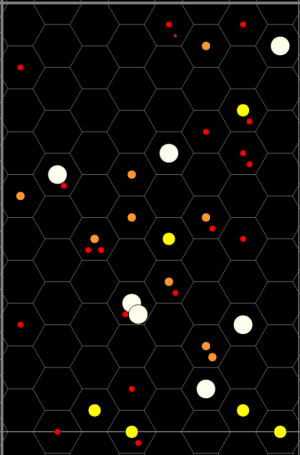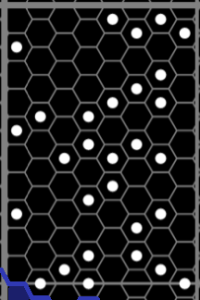Dortokh Subsector
| Dortokh Subsector | ||||||
|---|---|---|---|---|---|---|
| ||||||
| Sector | Gzaekfueg | |||||
| Capital | Ksikhsoloug | |||||
| No. of Stars | 29 | |||||
| Majority Control | Ruler of Five - 76% | |||||
| 2nd Control | Empire of Varroerth - 24% | |||||
Dortokh Subsector is Subsector A of Gzaekfueg Sector.
- It lies within Charted Space.
- It is part of the Vargr Extents.
Description / Specifications[edit]
Dortokh Subsector is a populated and prosperous region dominated by the Vargr.
- The resources of the subsector are being exploited.
Astrographic Features & Trade Routes[edit]
The following astrographic and commercial data has been determined regarding Dortokh Subsector:
- The subsector is a standard stellar density region.
- The brightest star is the white main sequence primary of the Atsngoerr system.
Stellar Distribution[edit]
A basic map showing the distribution and size of stars within Dortokh Subsector.
- The color corresponds to the visible color of the star, which links to its spectral classification.
- The size as shown indicates both the physical size of the object and its relative brightness.

(Chart sourced from Traveller Map).
Note that the stars as depicted are representative. Any star, no matter what its size, is a mere speck within the hex it occupies.
- Ordinary main sequence stars can barely be seen from even a hex away.
- Huge, intensely luminous giant stars can be seen from across the subsector and far beyond.
Rift Regions[edit]
The subsector lies on the edge of the Windhorn Rift.
A simple map showing rift regions within Dortokh Subsector.

(Chart sourced from Traveller Map)
Locally at least, a rift is an astrographic concept based on Jump Drive performance.
The boundaries of rifts were established centuries ago, when the highest commonly encountered tech level was TL–12.
- This level of technology allowed the routine use of up to Jump-3 drives.
- Areas that couldn't be crossed by Jump-3-capable vessels were denoted as rifts.
This traditional definition of rift regions remains in use today: while modern high performance starships can easily cross them, most commercial vessels continue to utilize Jump-3 or less drives. Because of this most traffic is concentrated within higher stellar density regions, and as such the classic definition and boundaries of rift regions remains relevant.
World Listing[edit]
AAB library archives contain expanded data about the following systems:
- The primary source material for all data is Traveller Map.
- Other sources may contain contradictory or incorrect information.
Note that some Second Survey data, though only 40 years old, is likely to be out of date.
- Data is occasionally updated as new information becomes available.
- Scouting missions gathering reliable, verified data can receive substantial payment.
- Verified updated data is constantly sought.
Subsector Summary[edit]
Dortokh, subsector A of Gzaekfueg contains 29 worlds with an estimated population of 7 billion, a per capita income of Cr3,078, and a total economy is BCr22,699. These worlds originate an interstellar trade of BCr152 through 21 starports (2 Class A, 2 Class B, 13 Class C, 4 Class D) employing 16,585 people. Driving this interstellar trade are six Agricultural (Ag) worlds, four Non-Agricultural (Na) worlds, no Pre-Agricultural (Pa) worlds, no Pre-Industrial (Pi) worlds, no Rich (Ri) worlds, and one Industrial (In) world. The governments in Dortokh maintain six Corsair bases, and three Naval bases. The average technology level is 5 (with most between 2 and 8). The highest technology level is 13 at Vuvikou (Gzaekfueg 0603).
Dortokh, subsector A of Gzaekfueg contains 42 stars and no identified planets; 19 monostellar systems, eight binary systems, one trinary system, and one system with four or more stars. 22 of the 29 systems (75%) have native gas giants. There are one Asteroid (As) belt, two Desert (De) worlds, no Garden (Ga) worlds, one Ice-capped (Ic) world, six Poor (Po) worlds, one Vacuum (Va) world, and two Water (Wa) or Ocean (Oc) worlds.
Dortokh has an estimated population of 7 billion distributed across one High population (Hi) world, no Moderate population (Ph) worlds, 22 Non-industrial (Ni) worlds, five Low population (Lo) worlds, and no Barren (Ba) worlds. The highest population world is Gorsakhsang (Gzaekfueg 0306). The population consists of 1 sophont groups.
| 1 identified sophont populations in Dortokh | |
|---|---|
Ruler of Five[edit]
The Ruler of Five has jurisdiction over 22 worlds with an estimated population of 6 billion, a per capita income of Cr3,391, and a total economy is BCr22,065. These worlds originate an interstellar trade of BCr128 through 15 starports (1 Class A, 2 Class B, 9 Class C, 3 Class D) employing 14,200 people. Driving this interstellar trade are five Agricultural (Ag) worlds, two Non-Agricultural (Na) worlds, no Pre-Agricultural (Pa) worlds, no Pre-Industrial (Pi) worlds, no Rich (Ri) worlds, and one Industrial (In) world. The governments in Ruler of Five maintain six Corsair bases. The average technology level is 5 (with most between 2 and 8). The highest technology level is 13 at Vuvikou (Gzaekfueg 0603).
The Ruler of Five has an estimated population of 6 billion distributed across one High population (Hi) world, no Moderate population (Ph) worlds, 17 Non-industrial (Ni) worlds, four Low population (Lo) worlds, and no Barren (Ba) worlds. The highest population world is Gorsakhsang (Gzaekfueg 0306). The population consists of 1 sophont groups.
Empire of Varroerth[edit]
The Empire of Varroerth has jurisdiction over seven worlds with an estimated population of 868 million, a per capita income of Cr730, and a total economy is BCr634. These worlds originate an interstellar trade of BCr23 through 6 starports (1 Class A, 0 Class B, 4 Class C, 1 Class D) employing 2,385 people. Driving this interstellar trade are one Agricultural (Ag) world, two Non-Agricultural (Na) worlds, no Pre-Agricultural (Pa) worlds, no Pre-Industrial (Pi) worlds, no Rich (Ri) worlds, and no Industrial (In) worlds. The governments in Empire of Varroerth maintain three Naval bases. The average technology level is 6 (with most between 3 and 9). The highest technology level is 11 at Ksikhsoloug (Gzaekfueg 0601).
The Empire of Varroerth has an estimated population of 868 million distributed across no High population (Hi) worlds, no Moderate population (Ph) worlds, five Non-industrial (Ni) worlds, one Low population (Lo) world, and no Barren (Ba) worlds. The highest population world is Kedanksek (Gzaekfueg 0501). The population consists of 1 sophont groups.
History & Background (Dossier)[edit]
The Vilani had contact with the Gvegh, Aekhu and Logaksu before -2400 in regions such as Provence Sector, though the Vargr were initially seen more as a curiosity than a threat. The Vargr in turn learned of the vast, immensely wealthy, and militarily weak human empire, a temptation that was impossible for them to ignore. Within a few decades the Vargr were actively raiding Vilani settlements in Windhorn and Corridor Sectors. The Vilani in turn moved the majority of their defenses towards these areas.
Other Vargr racial groups (the proto-Irilitok, Ovaghoun, Suedzuk and Urzaeng) took longer to find a path around the coreward end of the Windhorn Rift, but when routes were eventually found they made a beeline for the poorly defended coreward edge of the Ziru Sirka and its riches. These regions, already stripped of their meager defenses to prop up sectors further to spinward, were easy prey for the new waves of Vargr. The vast distances the Vargr had to travel limited the numbers of raiders who actually reached the Ziru Sirka: substantially more Vargr found promising worlds en route and decided to settle them instead.
The earliest exploration and settlement of Dortokh subsector was conducted using Jump-1 starships, constructed with large fuel tanks allowing consecutive jumps. The first Vargr explorers entered the region via the Uengkikgi system: increasingly high performance vessels followed other routes into the region, particularly through Gvaengfadz. Over time bases and settlements sprang up along the raiding routes to support the Corsairs. Successive waves of Vargr, either moving to rimward in search of plunder or a better life, or returning to coreward laden with treasures, increased local populations.
Because it has the only shipyard in the subsector, Ksikhsoloug serves as the capital. The Empire of Varroerth has sought to exert its power by siting naval bases on Aekksakhazo, Khullung, and Kedanksek, with vessels from its fleet actively patrolling the systems under its control. Smuggling between the Empire and interests within the Ruler of Five is rampant, and outright piracy goes unchecked within territory under that state's control.
Polity Listing[edit]
The following polities lie within this subsector:
Native Sophonts (NILs)[edit]
No races (sophont species) are believed to have originated in this area.
Demographics[edit]
Significant populations of the following races (sophont species) reside within this area:
- Terragens (Non-human Terran races)
- Vargr (Major Race): almost entirely Urzaeng Vargr, though a few Logaksu Vargr travel within the region to conduct business.
- Humaniti (Human Races)
- Non-Human Races
- Aezorgh of Soghzalghag: small populations on many Vargr-dominated worlds.
- Hlanssai of Vrirhlanz: typically wanderers and traders.
Major Historical Events Timeline[edit]
Major events that have affected this subsector and the wider region that it lies within:
- -3810: the Vargr discover jump technology and begin an era of expansion.
- -3700s onwards: waves of Vargr settle worlds across the region.
- -2404 to -2215: the human Interstellar Wars rage to rimward.
- -1998: the First Empire of Gashikan is formed.
- -1776 to 0: the Long Night. There is widespread regression within the area and some worlds become barren.
- -1700 onward: Vargr expansion and settlement gradually ceases.
- -1658: the Sack of Gashikan, an atrocity known throughout the coreward parts of Charted Space.
- -1483 to -321: the Gashikan Race Wars rage between human and Vargr extremists across the Extents.
- -1427: the Wolvesbane plague is released in Gashikan Sector, decimating Vargr populations.
- The Year 0: to rimward, the Third Imperium is founded.
- circa 26: to spinward, the Empire of Varroerth is founded.
- circa 30: the earliest precursor states that later become the Ruler of Five Confederation emerge.
- circa 170: the various Ruler of Five precursor states begin a centuries-long war of dominance.
- 175 to 191: the Julian War.
- 300 to 420: the Imperial First Survey charts the subsector.
- circa 500: the Ruler of Five Confederation draws up its charter, establishing the state in its current form.
- 995 to 1065: the Imperial Second Survey charts the subsector.
- 1065: the Second Survey is published. Information about the subsector becomes widely available.
- 1070: the Second Empire of Gashikan is shattered by civil war.
- 1078: the Third Empire of Gashikan forms.
Later Eras[edit]
- after 1116: the Empress Wave enters the region from coreward.
- after 1135: Virus enters the region from rimward.
References & Contributors (Sources)[edit]
| This article is missing content for one or more detailed sections. Additional details are required to complete the article. You can help the Traveller Wiki by expanding it. |
- John Harshman, Marc Miller, Loren Wiseman. Classic Traveller Supplement 8 Library Data (A-M), (Game Designers Workshop, 1981), various pages. (Library data entries)
- John Harshman, Marc Miller, Loren Wiseman. Classic Traveller Supplement 11 Library Data (N-Z), (Game Designers Workshop, 1982), various pages. (Library data entries)
- J. Andrew Keith, Marc Miller, John Harshman. Classic Traveller Vargr (Game Designers Workshop, 1984), IBC. (Subsector depicted but no further data provided)
- James Holden, Joe D. Fugate Sr., Terrance McInnes. Vilani & Vargr (Digest Group Publications, 1990), pages 11, 48, 49. (Dot maps providing the locations of worlds within the subsector and their political allegiances)
- David Burden, Stuart Dollar, Andy Lilly, Joseph Walsh. T4 Aliens Volume 1 (Imperium Games, 1998), pages 91-182. (The Vargr)
- David L. Pulver. GURPS Traveller Alien Races 1 (Steve Jackson Games, 1998), pages 64-99. (The Vargr)
- Simon Beal. Mongoose Traveller: Vargr, (Mongoose Publishing, 2009), various pages. (Background for the Windhorn Rift region)
- External Link: Undeveloped Sectors by John G. Wood
- Author & Contributor: John G. Wood (Generated data)
- Author & Contributor: Pakkrat
